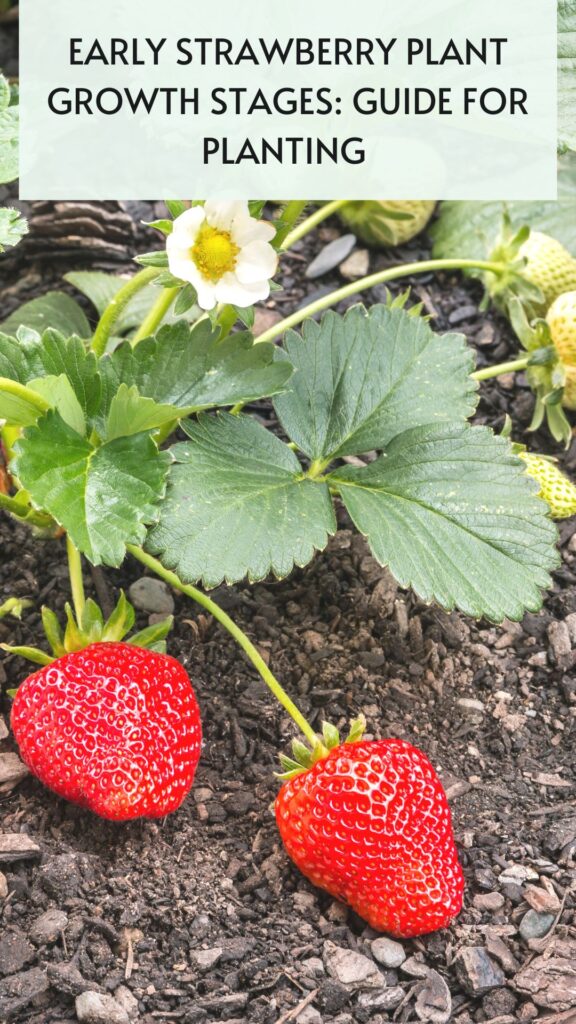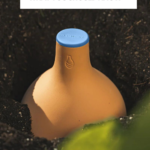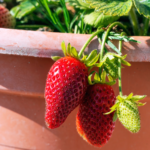Interested in the the early strawberry plant growth stages? As a gardener with strawberries in their garden, I know how important it is to understand the early growth stages of strawberry plants. These stages play a crucial role in determining the yield and quality of the final harvest.
In this article, I will share my knowledge and experience about the early growth stages of strawberry plants and provide valuable insights for other gardeners.
FTC DISCLOSURE: Some of the links in this post are affiliate links. If you click on them and make a purchase, I will receive a small finder’s fee on the sale. This does not increase your price in any way shape or form. Using these links help support the continuation of this website. All opinions are my own. Thank you in advance.
The first stage of strawberry plant growth is the germination stage. During this stage, the strawberry seeds start to sprout and develop roots. It usually takes around 7 to 14 days for the seeds to germinate, depending on the temperature and moisture level of the soil.
As a gardener, it’s important to ensure that the soil is moist but not waterlogged during this stage, as excessive moisture can lead to seed rot. You will end up halting your growing season before it even starts.
The second stage of strawberry plant growth is the vegetative stage. During this stage, the plant develops leaves and stems and starts to grow rapidly. This stage usually lasts for around 30 to 45 days, depending on the variety of the plant.
It’s important to provide the plant with adequate sunlight, water, and nutrients during this stage to ensure healthy growth for the new plants. This will also help support fruit production in the long run.
Life Cycle of Strawberry Plants
Strawberry plants go through several stages especially in the first year. These stages are the germination stage, vegetative stage, flowering stage, and fruiting stage.
Germination Stage
At the germination stage, strawberry plants start as a tiny strawberry seed. When the conditions are right, seeds will absorb water and begin to grow. The first thing that emerges from the seed is the root. The strawberry roots grows down into the soil, and the shoot grows up towards the surface. As the shoot emerges from the soil, it will develop its first leaves.
Vegetative Stage
During the vegetative stage, the strawberry plant focuses on growing leaves and roots. My roots will continue to grow deeper into the soil, and my leaves will grow larger and more numerous.
During this stage, they need plenty of water, soil with good drainage, and nutrients to support my growth. It’s best to choose soil with a good organic fertilizer or compost rich sandy loam soil This will work wonders for strawberry seedlings.
Flowering Stage
Once the strawberry roots have grown enough, they will enter the flowering stage. During this stage, they will produce flower buds. The flowers are small and white, and they grow in clusters. In order to produce fruit, the flowers need to be pollinated. This is usually done by bees and other insects. I did not know that strawberry fruits start out as actual flowers before I started growing my own.
Fruiting Stage
After the flowers have been pollinated, they will enter the fruiting stage. During this stage, the flowers will develop into small green strawberries. As the strawberries mature, they will turn red and become sweeter. When the strawberries are ripe, they can be harvested and eaten.
Early Growth Stages
Planting
When it comes to planting early strawberry plants, I always make sure to choose a location that receives plenty of direct sunlight. I also ensure that the soil is well-drained and has plenty of organic matter.
Before planting, I conduct a soil test to determine if any additional amendments are necessary to provide the best growing conditions for my strawberry plants. This sets your strawberry patch to grow healthy plants.
Soil Requirements
Strawberry plants require soil that is rich in nutrients and well-drained. I always make sure to add plenty of organic matter to the soil before planting, such as compost or aged manure. This helps to provide the necessary nutrients for the plants to grow strong and healthy. This can even be done with the no-dig gardening method.
Watering
During the early growth stages of strawberry plants, it is important to keep the soil consistently moist but not waterlogged. I typically water my plants deeply once a week, but adjust the frequency depending on the weather conditions.
It is important to avoid overhead watering, as this can lead to the development of fungal diseases. Some people use straw mulch to help keep the root moist. But, be sure to choose clean and pesticide free straw to avoid disease on your plants.
Light Requirements
Strawberry plants require plenty of direct sunlight to thrive. I always make sure to choose a location that receives at least 6 hours of direct sunlight per day. If the plants are not receiving enough sunlight, they may become leggy and weak, which can impact their overall growth and yield.
Runner Plants
As I observe the early growth stages of strawberry plants, I notice the formation of runner plants. Runner plants, also known as stolons, are horizontal stems that grow from the mother plant and produce new daughter plants. In this section, I will cover the runner formation, runner care, and daughter plants.
Runner Formation
The formation of runners typically occurs in the early summer months or warm climates, after the plant has produced flowers and fruit. As the plant grows, it produces long, thin stems that extend outwards from the mother plant. These stems eventually develop roots and small leaves, forming new plants. The original plants become known as the parent plants.
It’s important to note that not all strawberry varieties produce runners. If you’re interested in growing runnerless varieties, do your research to find the best fit for your garden.
Runner Care
To ensure healthy runner plants, it’s important to provide adequate care. Regular watering and fertilization will help the runners establish strong roots and grow into healthy plants. It’s also important to remove any weeds or other plants that may compete with the runners for nutrients.
As the runners grow, they may need to be tied down to prevent them from becoming tangled or damaged. You can use garden twine or small stakes to secure the runners in place.
Daughter Plants
The daughter plants that form from the runners are genetically identical to the mother plant. They can be left in place to form a dense ground cover, or they can be transplanted to a new location.
When transplanting daughter plants, it’s important to handle them carefully to avoid damaging the fragile roots. Plant them in a location with well-draining soil and plenty of sunlight.
Nutrient Requirements
Compost and Fertilizer
As I observed the early stages of strawberry plant growth, I noticed that these plants require a lot of nutrients to grow properly. One way to ensure that your plants are getting the nutrients they need is by using compost and fertilizer.
Compost is a great source of nutrients for your plants, and it also helps to improve soil structure and water retention. When making compost, it is important to use a variety of organic materials such as kitchen scraps, leaves, and grass clippings to ensure a good balance of nutrients.
Fertilizers can also be used to provide your plants with the necessary nutrients. There are many different types of fertilizers available, including organic and synthetic options. When choosing a fertilizer, it is important to consider the nutrient content and the needs of your plants.
Nutrient Deficiencies
Even with the use of compost and fertilizer, it is still possible for your plants to experience nutrient deficiencies. Common nutrient deficiencies in strawberry plants include nitrogen, phosphorus, and potassium.
A soil test can help you determine which nutrients your plants are lacking. Once you know which nutrients are deficient, you can make adjustments to your compost and fertilizer to address the issue.
In addition to nutrient deficiencies, it is also important to be aware of nutrient toxicities. Overuse of fertilizers can lead to an excess of certain nutrients, which can be harmful to your plants. Be sure to follow the instructions on your fertilizer carefully to avoid this issue.
Overall, providing your strawberry plants with the right nutrients is crucial for their growth and development. By using compost and fertilizer and monitoring for nutrient deficiencies, you can ensure that your plants are healthy and productive.
Pest and Disease Management
Common Pests
As a strawberry grower, I know that pests can be a major problem during the early stages of plant growth. Some of the most common pests that can attack young strawberry plants are aphids and beetles.
Aphids can cause significant damage to the plants by sucking the sap from the leaves, which can stunt growth. Beetles, on the other hand, can eat the leaves and flowers, which can reduce the yield of the crop.
To prevent aphids and beetles from attacking the plants, I regularly inspect the plants for signs of infestation and use insecticides as necessary. I also use physical barriers, such as row covers, to prevent the pests from accessing the plants.
Common Diseases
Diseases can also be a major issue during the early stages of strawberry plant growth. Some of the most common diseases that can affect young plants include powdery mildew, verticillium wilt, and crown rot. Powdery mildew is a fungal disease that can cause a white powdery coating on the leaves, which can reduce photosynthesis.
Verticillium wilt is a soil-borne disease that can cause the leaves to wilt and turn yellow. Crown rot is a fungal disease that can cause the crown of the plant to rot, which can kill the plant.
To prevent these diseases, I make sure to plant disease-resistant varieties of strawberries and use proper soil management practices. I also make sure to water the plants properly at the root and not so much on the leaves and avoid over-fertilizing, which can increase the risk of disease.
Preventative Measures
Preventative measures are the most effective way to manage pests and diseases in strawberry plants. To promote plant health and vigor, I make sure to provide adequate nutrition, water, and sunlight. I also make sure to remove any dead or diseased plant material to prevent the spread of disease.
To promote pollination, I make sure to provide habitat for pollinators, such as bees and butterflies. I also avoid using pesticides that can harm pollinators.
Varieties of Strawberry Plants
As I explore the early stages of strawberry plant growth, it’s important to understand the different types of strawberries. There are three main types of strawberry plants: June-bearing, ever-bearing, and day-neutral.
June-Bearing Strawberry Plants
June-bearing strawberries are the most common type of strawberry plant. They produce a single, large crop of fruit in early summer, usually in June. These plants require a period of cold temperatures in the winter to produce fruit. They are also known as “short-day” plants, meaning they require less daylight to produce fruit.
Some popular varieties of June-bearing strawberry plants include:
- Chandler
- Jewel
- Allstar
- Earliglow
- Seascape
Ever-Bearing Strawberry Plants
Ever-bearing strawberries produce fruit twice a year – once in the late spring and again in the early fall. They require less cold temperatures than June-bearing plants, but still need a period of dormancy in the winter. Ever-bearing strawberries are also known as “day-neutral” plants, meaning they can produce fruit regardless of the length of daylight.
Some popular varieties of ever-bearing strawberry plants include:
- Tribute
- Ozark Beauty
- Fort Laramie
- Quinault
- Albion
Day-Neutral Strawberry Plants
Day-neutral strawberry plants produce fruit continuously throughout the growing season, from spring until fall. They require the least amount of cold temperatures of all the strawberry plant types. Day-neutral strawberries are also known as “ever-bearing” plants, but they differ from the ever-bearing type in that they can produce fruit even during long days.
Some popular varieties of day-neutral strawberry plants include:
- Tristar
- Seascape
- Tribute
- Selva
- Fern
By understanding the different types of strawberry plants, you can choose the best variety for your specific growing conditions and needs. Whether you prefer a single large crop of fruit or continuous smaller harvests, there is a strawberry plant variety that will work for you.
Harvesting and Production
Harvest Time
As I monitor the early stages of strawberry plant growth, I keep a close eye on when the fruits are ready for harvest. Harvest time typically occurs around 30 days after the flowers have been pollinated.
At this point, the fruits will have reached their full size and will have developed their characteristic red color. I make sure to harvest the fruits as soon as possible to ensure maximum freshness and quality.
Fruit Production
When it comes to fruit production, I have found that the early stages of strawberry plant growth are crucial. Vigorous plants with healthy roots will produce more fruits than weaker plants. Additionally, I make sure to provide the plants with the necessary nutrients and water to ensure optimal growth and fruit production.
Yield and Quality
The yield and quality of the strawberries are also important factors to consider during the early stages of plant growth. I have found that the yield can be increased by planting the strawberries in rows with adequate spacing between them.
This allows for better air circulation and reduces the risk of disease. Additionally, I make sure to remove any damaged or diseased fruits to ensure that only high-quality fruits are harvested.
Overall, the early stages of strawberry plant growth are critical for harvesting and production. By monitoring the plants closely and providing them with the necessary care, I am able to ensure that the fruits are of the highest quality and yield.
Winter Care
As a strawberry plant grower, I know that winter is a critical time for the survival of my plants. Proper care during this season can make all the difference in the growth and yield of my strawberry plants. In this section, I will discuss the three main aspects of winter care for strawberry plants: dormancy, winter hardiness, and support system.
Dormancy
During the winter, strawberry plants enter a state of dormancy. This means that they stop growing and conserve energy until the spring when conditions become more favorable for growth. To promote dormancy, I make sure to stop fertilizing my plants in the late summer or early fall. This helps the plants shift their focus from growth to energy conservation.
Winter Hardiness
Strawberry plants are generally winter hardy, but it is still important to protect them from harsh weather conditions. I cover my plants with a layer of straw or hay to insulate them from the cold and prevent the soil from freezing. This also helps to keep the plants dry and prevent the growth of mold or fungus.
Support System
The weight of snow and ice can damage strawberry plants and even break their branches. To prevent this, I use a support system to keep the plants upright and stable. I use stakes and twine to create a framework around the plants, which helps to distribute the weight of snow and ice evenly.
In late winter, when the weather starts to warm up, I remove the straw or hay from around my plants and prune any dead or damaged branches. This helps to promote new growth and prepare the plants for the upcoming growing season.
Overall, winter care is an essential part of growing healthy and productive strawberry plants. By promoting dormancy, ensuring winter hardiness, and providing a support system, I can help my plants survive the winter and thrive in the spring.












